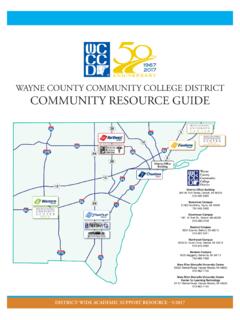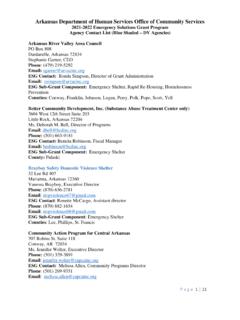Transcription of Close Reading - Bucks County Community College
1 BCCC ASC Rev. 3/2019 Close Reading Close Reading is a method of literary analysis which focuses on the specific details of a passage or text in order to discern some deeper meaning present in it. The meaning derived from the Close Reading is the reader s interpretation of the passage or text. Tip: There is no such thing as the one true meaning behind a text, so any interpretation which can be supported by the text s specific details is valid. Don t worry about arguing for the correct interpretation of a text or passage and don t be afraid to be creative in your analysis. Close Reading tends to rely on the principle that no details are present in a text by accident.
2 The author s conscious intentions in writing are often insignificant, as unconscious layers of meaning or even prejudices may be sublimated into literary works. Regardless of whether an author consciously or unconsciously constructs a particular meaning in a text, if details are present which support that interpretation, it is valid. How to Begin a Close Reading A Close Reading should never be your first Reading of a text. Before focusing on the details of a text or passage, it is important to have an understanding of the text as a whole. Read the text! Make sure that you understand its plot, who the characters are, etc. For more difficult texts, it may take more than one read to do this.
3 That is normal. The better your overall understanding of the text, the easier it will be to focus on its details and/or the details of your chosen passage. When you are ready to begin your Close Reading , take your time! Read the text actively. Take notes. You may write on a separate sheet of paper, directly in your book, or you may even choose to make a photocopy of the text or passage and take notes on that. Choose the method which works best for you. Do not be afraid to pause to think over what you read as you read! Do not hesitate to read and re-read sentences or sections several times before moving on. Take note not only of the details in the text, but also of the impressions which those details create in you as a reader.
4 The purpose of a Close Reading is to squeeze the details from your chosen text and use those details to formulate an interpretation of a deeper meaning or impression present in the text. BCCC ASC Rev. 3/2019 Some Details to Consider When Reading Closely Titles Matter! Always take a moment to consider the title of your chosen text and its relationship to the content. The author has chosen the title carefully to represent the text as a whole. Often, titles may point to important symbols or images which you might then focus on more closely in your Reading . Example: In Nathaniel Hawthorne s short story The Birthmark or Charlotte Perkins Gilman s short story The Yellow Wallpaper, the titles refer to prominent symbols in the texts.
5 Paying Close attention to these symbols, how they are described, and how they are treated in the texts would be fertile ground for a Close Reading . Other titles may help to structure the reader s understanding of the text s content. Example: Jamaica Kincaid s short story Girl is a list of commands and instructions. The text does not clearly state who these commands are directed towards, but the title hints that they are commands for a specific girl, or perhaps girls in general. Audience and Purpose Who is the intended audience of the text or passage? What is its purpose? Audience and purpose may help to contextualize some of the text s details. Example: In Jonathan Swift s essay A Modest Proposal, he proposes that impoverished Irish communities eat their children in order to limit their financial burdens and gain a source of food.
6 Understanding Swift s purpose, to use an absurd and morally reprehensible argument to draw attention to the plights of these communities as well as to criticize the faulty and rather callous logic employed by many English intellectuals in discussing these issues, helps readers to understand his methods and the significance of the way he lays out his hyper-rational and fairly horrifying argument. Narrative Point of View The narrator is the voice through which the reader experiences the text. That means that all of the information a reader receives is colored by the narrator s perspective. Dissecting this perspective may help to inform your understanding of how the text relates its information and how that dynamic influences or constructs meaning within the text.
7 Is the text or passage narrated in 1st, 2nd, or 3rd person? Is the narrator omniscient (does he or she know all of the characters thoughts and actions)? Is the narrator s perspective limited to one character s experiences and thoughts? Is the narrator an impartial observer, a fly on the wall who simply relates the events of the text or passage without giving insight into characters thoughts and feelings? Does the narrator seem to make any judgments regarding the characters or events of the text? Is the narrator completely reliable? If the narrator may be biased, how does that influence the text? What biases might the narrator possess? Is he or she possibly insane, lying, or mistaken?
8 BCCC ASC Rev. 3/2019 Example: Jamaica Kincaid s short story Girl is narrated in 2nd person. This means that the narrator seems to directly address the reader in his or her stream of commands and instructions. The reader may feel overwhelmed, defensive, or resentful of the narrator as a result of the narrative point of view. Those feelings may mirror the feelings of a girl who is being lectured regarding proper or acceptable behavior. Therefore, the narration puts the reader in the position of the Girl. What is the relationship between the narrator and the Girl /reader? How might that be significant? Imagery and Symbols Often, a work of literature will emphasize a particular image.
9 Images appeal to our senses, so a text may include visual images, auditory images, images which involve smell, images which involve taste, and images which involve touch. What images do you find in the text or passage? Are there any images which appear to be emphasized more than others? Why? How does that affect the meaning of the text or passage? Some images may function as symbols in the text: images which have metaphorical meanings beyond their literal meanings. Are there any symbols present in the text? What metaphorical meanings might those symbols carry? If we accept those meanings, how does that influence our Reading of the text? Example: In Nathaniel Hawthorne s short story The Birthmark, Georgiana, the protagonist s wife, has a birthmark on her face in the shape of a small hand.
10 Her husband sees this as an imperfection, which he then seeks to correct by removing it. Georgiana dies during this process. One way to interpret Georgiana s birthmark is as a symbol of natural human imperfection. If we accept this symbolic meaning, then how do we read Georgiana s death? Does the text seem to be commenting on the whether or not human perfection is attainable? Characterization Who are the characters? Is there one protagonist (main character), in the text? Is there an antagonist (a character or force which opposes the protagonist)? If so, how does the conflict influence the text? Which characters are focused on and which characters are treated as secondary? How do we learn about the characters?



